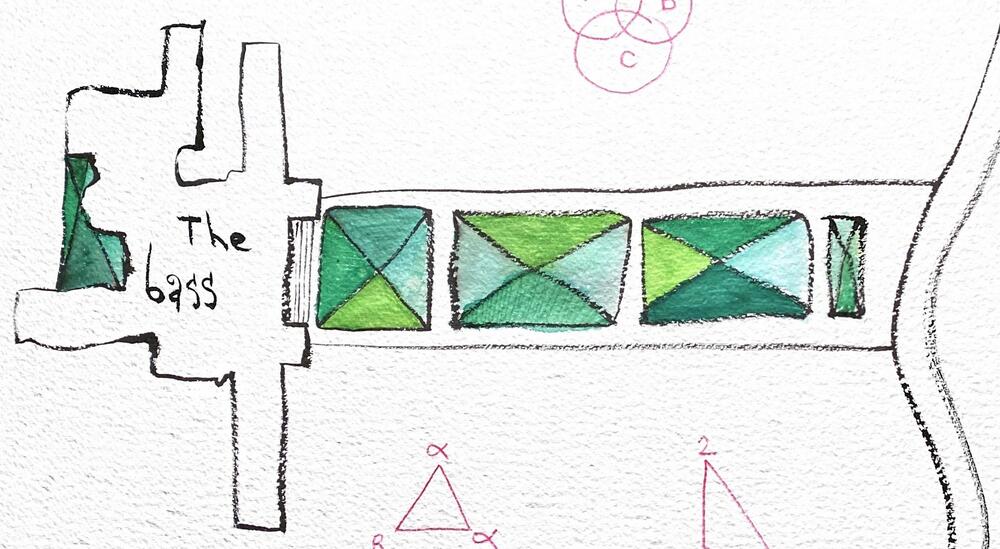AGUA DULCE – COMMISSIONED BY THE BASS MUSEUM TO ABRAHAM CRUZVILLEGAS
The installation is free and presented outdoors from November 29 to April 18. Curated by Silvia Karman Cubiñá (Executive Director and Chief Curator) and Leilani Lynch (Curator), from The Bass, it utilizes a selection of over 1,000 native plant species, fauna and mineral to form a planted environment in front of the museum.

Extending from Collins Avenue along the central promenade of the park leading up to the museum entrance, the installation encompasses nearly 14,000 square feet. Commissioned by the museum, Agua dulce (Fresh water) will bring the artist's philosophy of autoconstrucción or “selfconstruction,” a practice of resilience and generosity, to The Bass' Collins Park. It includes numerous species of flora, fauna and mineral; performers mimicking native birds; and seating that the artist constructed with locally sourced materials.
Agua dulce developed from a curatorial proposal and discussion with Cruzvillegas to utilize the adjacent Collins Park as a new, open-air site for his exhibition. Through collaborative research with local experts on native flora, Cruzvillegas selected around 23 different species to create the installation of more than 1,000 plants. Many of the included species, like the Salix Caroliniana (Coastal Plain Willow), have medicinal properties and are regularly used by the Seminoles, introducing notions of care and restoration to the installation.
Collaboration, adaptability, and a focus on “the local” are core tenets of Cruzvillegas’ practice that emerge within the exhibition out of necessity, as well as by design. Through the “reclaimed” landscape of native species, visitors can learn from and question their surrounding environment. “Agua dulce works within our changed reality where enclosed spaces are perceived as less safe, to imagine the park as an exhibition platform while redefining public greenspace as a site for healing and reflection," says curator Leilani Lynch. Following Agua dulce’s duration in Collins Park, the plants will be dispersed and rehoused within the community as a continuation of the project.
Abraham Cruzvillegas’s artistic process of autoconstrucción draws from the ingenious, precarious, and collaborative building tactics implemented by the people living in Colonia Ajusco, his childhood neighborhood in Mexico City. He appropriated this term in relation to his practice to describe an approach of inventive improvisation and instability. This work has led him to explore his own origins and to collaborate with family and friends in a very personal form of research that results in a constant process of learning about materials, landscape, people, and himself.
Through his oeuvre –which includes sculpture, painting, drawing, installation, and video–, Cruzvillegas uses a wide range of collected object: his sculptures challenge the traditional conceptions of art making; while his paintings and drawings are marked by a keen depiction of the subject and a strong sense of humor —instilled in him from his early training as a political cartoonist. Parallel to his artistic production, Cruzvillegas has cultivated writing as an investigative tool of self-analysis that merges history, criticism, and fiction. His song lyrics and texts about art, politics, and culture are a layer to be added to his aesthetic practice.
-
Preparative sketches for Agua dulce at The Bass by Abraham Cruzvillegas. Courtesy of the artist.
-
Preparative sketches for Agua dulce at The Bass by Abraham Cruzvillegas. Courtesy of the artist.
-
Preparative sketches for Agua dulce at The Bass by Abraham Cruzvillegas. Courtesy of the artist.
-
Preparative sketches for Agua dulce at The Bass by Abraham Cruzvillegas. Courtesy of the artist.
-
Preparative sketches for Agua dulce at The Bass by Abraham Cruzvillegas. Courtesy of the artist.
-
Preparative sketches for Agua dulce at The Bass by Abraham Cruzvillegas. Courtesy of the artist.
Abraham Cruzvillegas (b. 1968, Mexico City) studied Pedagogy from 1986 to 1990 at UNAM (Universidad Nacional Autónoma de México) in Mexico City while simultaneously attending Gabriel Orozco’s workshop Taller de los viernes. In 2012, he was the 5th laureate of the Yanghyun Prize and in 2006 he received the Prix Altadis d' arts plastiques. He lives and works in Mexico City.
The Bass is Miami Beach’s contemporary art museum. Founded in 1964 by the City of Miami Beach, the museum was established after the donation of a private collection by residents John and Johanna Bass and opened in what was formerly the Miami Beach Public Library and Art Center, a 1930s Art Deco building designed by Russell Pancoast. Its exhibition program encompasses a wide range of media and artistic points of view, bringing fresh perspectives to the diverse cultural context of Miami Beach.




